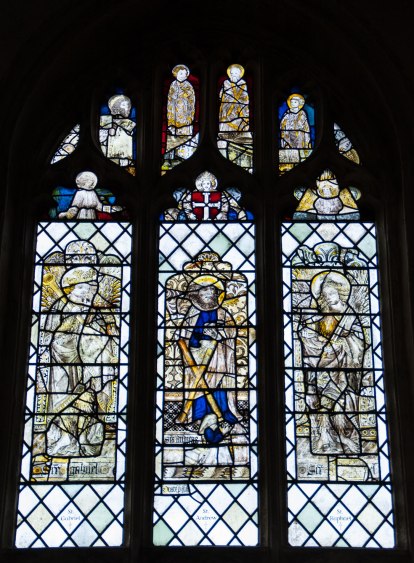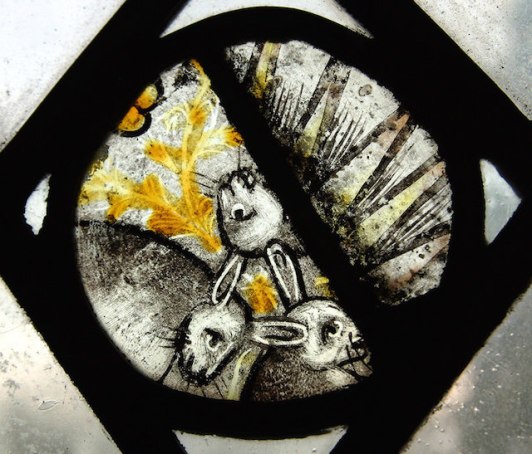 For anyone seriously interested in exquisite fifteenth-century stained glass then Long Melford in Suffolk is well worth a visit.
For anyone seriously interested in exquisite fifteenth-century stained glass then Long Melford in Suffolk is well worth a visit.

Finished in 1484 the Great Church of the Holy Trinity contains a collection of some of the finest medieval glass in the country including a Lily Crucifix image and a rare roundel featuring a three hares motif.
 Holy Trinity is one of Suffolk’s so-called ‘Wool churches’ as the erection of these buildings was funded from the profits of the medieval wool-trade. Advantaged Suffolk landowners prospered from the successful export of high quality wool and wool cloth to continental Europe and invested their profits building fine churches in the hope of facilitating a speedy journey for their soul through purgatory to heaven.
Holy Trinity is one of Suffolk’s so-called ‘Wool churches’ as the erection of these buildings was funded from the profits of the medieval wool-trade. Advantaged Suffolk landowners prospered from the successful export of high quality wool and wool cloth to continental Europe and invested their profits building fine churches in the hope of facilitating a speedy journey for their soul through purgatory to heaven.
The medieval glass we see today filling the large ground floor windows features portraits of donors. These portraits would originally have glazed the upper, smaller, clerestory windows. For about 100 years during the 19th century some of this glass was used to reglaze the east window (1828) with more being installed in the west windows during 1862/3, however today these windows are clear. The present arrangement of the medieval glass, all along the north aisle, was carried out during the late 1940s.

The height of these lofty clerestory windows helped protect the glass from the various destructive onslaughts that occurred during the 16th and 17th centuries. The lost/destroyed stained glass would have consisted of biblical images and religious themes popular in the medieval period and similar to those of the Victorian glass found in the south aisle windows today.
 In the medieval period clerestory windows were filled with a variety of images from Old Testament prophets and local church dignitaries to ethereal representations of angels and archangels. Amongst the many surviving medieval donor portraits (to be explored in a separate post) there are two archangels.
In the medieval period clerestory windows were filled with a variety of images from Old Testament prophets and local church dignitaries to ethereal representations of angels and archangels. Amongst the many surviving medieval donor portraits (to be explored in a separate post) there are two archangels.
Here, at Holy Trinity it is the archangels St Gabriel and St Raphael that have survived. They are both exquisitely painted displaying subtle and detailed work using silver nitrate stain. They have been painted by a craftsman that understood how to use the translucent quality of his materials to achieve an unearthly quality, literally letting the spirit/light shine through.
There is another little gem hidden away in the Clopton Chantry Chapel. One of only five examples in England, the east window of the chapel bears a ‘Lily Crucifix’ dated from 1350. Christ is not on the Cross, but is instead crucified on white lilies. The blue background and the white lily represent the Virgin Mary and the motif symbolises the joint suffering of Mary and Jesus.
Finally, an unusual and rare three hares roundel has been placed above the north door. This motif is believed to have come to Europe from perhaps as far away as China via the Silk Road. If you look carefully you can see that although there are only three ears each of the three hares has two ears!













The annoying thing is that I have been to Long Melford but I haven’t been to the church. Now I feel I’m missing out!
As an art history type it’s been on my list to visit for years, but I have to admit I actually went to hear an afternoon of Bach. Ended up a double treat.
These are lovely – thank you.
My pleasure – could have done with being up a ladder though.
At the very top of Manchester town hall steeple/spire (on the inside) there’s a sack of cotton (I think) probably representing the cotton industry. It was probably the Victorian cotton industry that funded the building. I’ve found a website debating whether this exists but I have seen this with my own eyes, probably photographed it, and just forget the minor details.
Well, there’s nothing shy about these cloth/textile business folk – why not splash some cash and fund a large building or two for posterity.
I love your guided tours. So informative, and with great illustrations.
Thanks – it was good to finally see in real life some stained glass that I referenced years ago when I did my Master’s. Better late than never!
A wonderful treat to be able to see this beautiful glass. And such an imposing church. The benefactors must have been VERY anxious for their immortal souls.
They certainly seemed to have their eyes on a future afterlife. I think it’s difficult for us to appreciate how different their lives were. Life expectancy for a boy that survived to adulthood was about 45 years old – of course, much bleaker for a woman with, according to some sources, 1 in 10 pregnancies ending in maternal death. This wealthy bunch portrayed in the glass were very lucky on Earth and obviously felt they should maximise efforts to ensure they would carry on in the same vein on their arrival in heaven!
I was just looking at a family will from early 20th century. He is shaping up to be a bit nasty in life, but in the will he is splashing bequests around to various charities, that better the life of those in need, so perhaps another last minute run to save his soul?
Ah yes – ‘wills’, such a Dickensian way of managing your legacy and influencing the living after you’ve departed. For early 20th century folk hard to tell whether an individual was negotiating with heaven as so many people of faith were undone by the First World War, but I guess they could still have been hedging their bets on an afterlife.
Come to think of it, this particular family is one of the few I have looked at who did not have a close person serving in WWI.
Fascinating information and I guess moving the older stained glass windows down to the lower level means we all expect a lasting peace with no fear of breakage. The lily crucifixion window is amazing for its antiquity and content! …the three hares too although, did they have religious significance? Even though the rich were just greedily trying to buy their way into eternity at least they left us a beautiful piece of history.
Ah the three hares – earliest example, 6th century, is in a Buddhist temple in China. In the UK quite a few carved medieval examples (roof bosses) have been found in parish churches down in Devon, but no clear idea or agreement regarding religious meaning. For the Long Melford example – I tentatively agree with the folks who suggest maybe it’s the Trinity for Eternity, three for the Trinity and chasing round the circle forever signifying eternity. I think locality and context is important. I just wonder why and who placed it above the north door and whether that was it’s original site. Yes, I agree with you, if not for the worried rich building in stone we’d have vastly less medieval culture to feast our eyes on.
Some amazing stained glass artwork and a wonderful story to accompany the images Agnes.
It’s a lovely Church. And, the acoustics were excellent for listening to young, talented singers performing Bach.
What a beautiful Suffolk wool church. The face in the ‘St Raphael’ glass is typically C15th Norwich School. Perhaps surprising how far its influence spread.
Yes, I think it’s definitely considered to be the work of the medieval Norwich School. The faces of the archangels are very similar to work at East Harling and some faces in the East Window of St Peter Mancroft. For example, there’s an ‘angel’ face patched into the ‘St Francis Receiving the Stigmata’ panel. Even more interesting is the possible influence of the painted rood screen at Ranworth. http://vidimus.org/blogs/news/medieval-rood-screens-in-east-anglia/ Interestingly, I have also been told about the possibility of ‘medieval’ pattern books being available to the artisans of Norwich which could explain how very similar faces and motifs appear in different media in both Norfolk and Suffolk churches.
Thank you for reading and taking the time to comment.
Woodforde (The Norwich School of Glass Painting) talks of sketchbooks being used within a group. In some cases it’s even possible to superimpose ‘Norwich’ faces, indicating the use of cartoons or templates (http://wp.me/p71GjT-t). Really enjoying your blog.
David King thinks that very little of the glass here was made in Norwich, with only the two mainlight figures of angels definitely coming from there, and perhaps a few other smaller pieces. The source of the rest is, at present, an enigma, a great puzzle, because so many different styles and hands are involved. Some glass may have been brought in too from other, perhaps local, churches…….. It would seem that there was probably a stained glass workshop in Bury St Edmunds, and the magnificent quality of much of the glass might indicate a London workshop; but this is all conjectural.